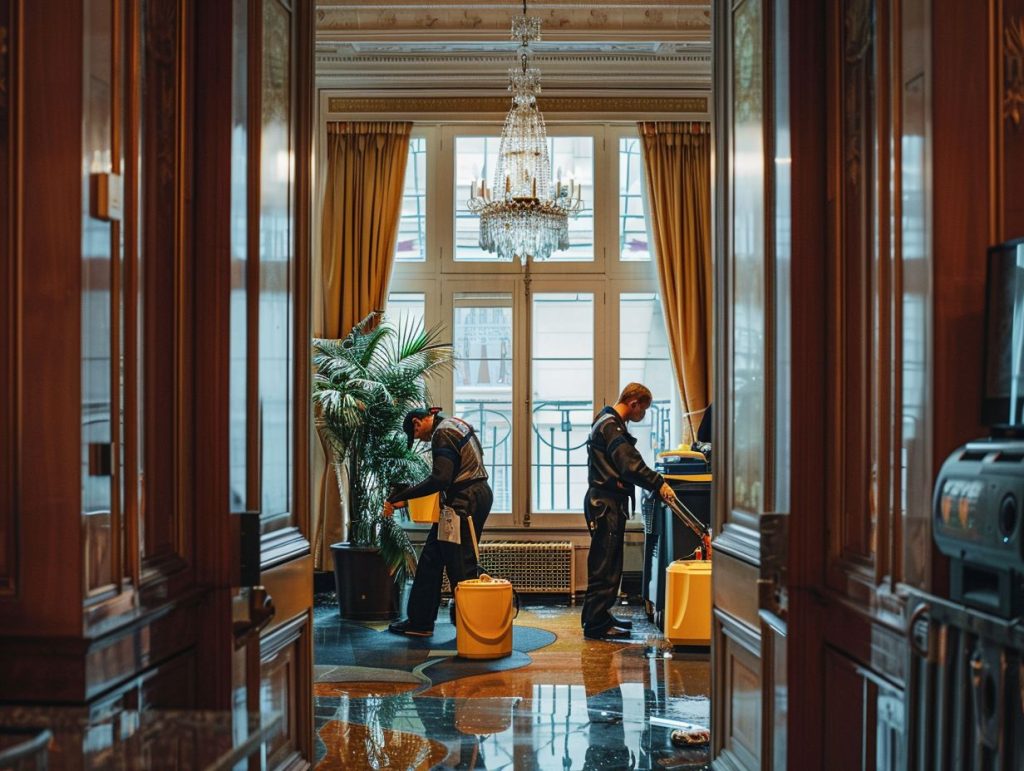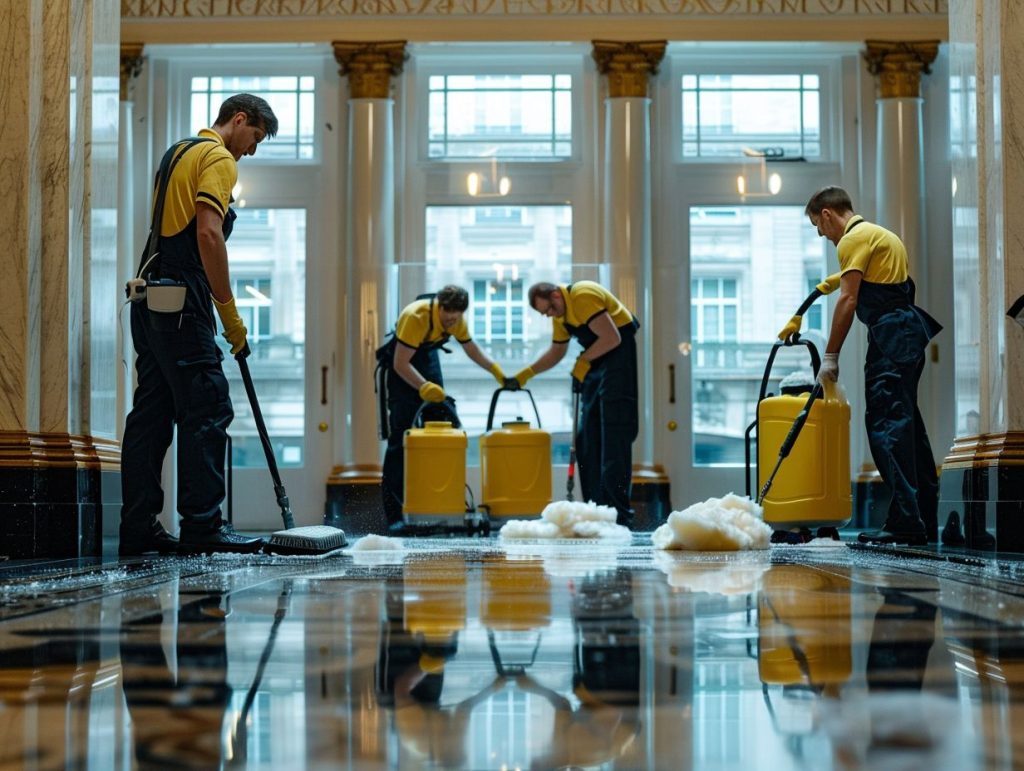Maintaining a clean and organised office space is crucial for creating a productive and professional work environment as a small startup. We explore the importance of office cleaning for small businesses and the factors to consider when setting up an office cleaning budget.
From the office space size to the type of cleaning services needed, we discuss creating a budget that meets your cleaning requirements while staying within your financial constraints. We look at the office cleaning services and how much they typically cost.
What Factors Should Be Considered When Setting Up an Office Cleaning Budget?
When setting up an office cleaning budget for a small startup, various factors must be considered, such as the office space size, cleaning frequency, type of cleaning services needed, number of employees, and any special cleaning requirements.
The size of the office is a significant factor impacting the budget, as larger spaces require more time and resources for cleaning. Deciding on the frequency of cleaning services is crucial, as daily, weekly, or monthly cleaning schedules will have different cost implications. Considering the number of employees in the office plays a role in determining the level of cleaning needed. Special cleaning requirements, such as carpet cleaning or window washing, should also be factored in to ensure an accurate budget allocation for effective cost control.
Size of the Office Space
The size of the office space plays a significant role in determining the cost of office cleaning services for small startups. Larger spaces often require more extensive cleaning routines, leading to higher expenses.
When evaluating the cost of cleaning services based on office dimensions, a thorough cost analysis is crucial to determine the most cost-effective solutions.
Small offices can benefit from regular maintenance schedules and eco-friendly cleaning products, which can help manage costs while maintaining a sanitary workplace environment.
In contrast, larger office spaces may benefit from outsourcing cleaning services to specialised companies offering bulk discounts or tailored packages.
By assessing the specific needs of each office size, businesses can strike a balance between maintaining cleanliness and effectively managing cleaning expenses.
Frequency of Cleaning
The frequency of cleaning is a critical factor in office maintenance for small startups. Regular cleaning schedules ensure workplace sanitation and contribute to a clean work environment conducive to employee productivity.
Maintaining a consistent cleaning frequency keeps the office looking tidy and significantly prevents the spread of germs and bacteria. A clean workspace can minimise employee sick days, boost morale, and enhance overall well-being. Employees who feel comfortable in their work environment are more likely to perform efficiently and be motivated throughout the day. Therefore, establishing a suitable cleaning routine tailored to the office’s size and foot traffic can significantly impact the health and productivity of employees in small startup offices.
Type of Cleaning Services Needed
Determining the specific type of cleaning services needed is crucial for small startups aiming to maintain workplace sanitation efficiently. Choosing the correct cleaning practices can help optimise the cleaning process and ensure a clean work environment.
This selection process should consider various factors, such as the office space size, the nature of the business operations, and the frequency of cleaning required.
Tailoring the cleaning services to meet the startup’s unique needs can significantly impact the workplace’s overall cleanliness and hygiene standards. Efficient cleaning practices contribute to a more pleasant and productive work environment and play a vital role in preventing the spread of germs and illnesses among employees, ultimately promoting overall well-being and productivity.
Number of Employees
The number of employees in a small startup directly impacts the cleaning requirements for the office space. Employees may require frequent cleaning and efficient resource allocation to ensure workplace sanitation.
Adapting cleaning schedules to maintain a hygienic environment becomes crucial as the workforce grows. With a larger team, shared spaces like kitchens and restrooms are used more often, requiring attentive cleaning protocols and adequate supplies.
Small startups can benefit from implementing a structured cleaning routine tailored to the number of staff members, ensuring that high-traffic areas receive proper attention. By optimising cleaning practices based on employee count, companies can effectively manage costs while upholding a clean and inviting workspace for everyone.
Special Cleaning Requirements.
Small startups have special cleaning requirements, such as unique surfaces or sensitive areas, that demand tailored cleaning approaches. Adhering to specific cleaning standards ensures that these requirements are met effectively.
This attention to detail is crucial to maintaining workplace sanitation and a healthy environment for employees. For instance, areas with electronic equipment necessitate specialised cleaning to prevent damage. Sensitive spaces like break rooms or restrooms require frequent deep cleaning to prevent the spread of germs and maintain a hygienic workspace.
By proactively addressing these specialised cleaning needs, startups can cut down on long-term costs and ensure employee well-being. Customised cleaning routines enhance workplace aesthetics and increase employee productivity and overall satisfaction.
What Are the Different Types of Office Cleaning Services?
Office cleaning services for small startups encompass a range of options, including commercial cleaning, janitorial services, and speciality cleaning services tailored to meet specific cleaning needs.
Commercial cleaning services typically involve thoroughly cleaning the entire office space, including common areas, workstations, and restrooms.
On the other hand, janitorial services focus on daily cleaning tasks such as rubbish removal, vacuuming, and mopping.
Speciality cleaning services target areas like carpets, windows, or high-touch surfaces to ensure a deep and specialised level of cleanliness.
Each type of service plays a significant role in maintaining a healthy and productive work environment for employees, ultimately enhancing the workplace’s overall well-being and efficiency.
Basic Cleaning Services
Essential cleaning services form the foundation of office maintenance for small startups, covering essential tasks outlined in a cleaning checklist. These services focus on routine cleaning to uphold workplace sanitation standards.
Regular cleaning checklists are crucial in ensuring that offices remain clean and germ-free. They detail tasks such as dusting, hoovering, mopping, and sanitising common areas. By consistently following these cleaning routines, small startup offices can create a healthier work environment, reducing the spread of germs and promoting employee well-being.
Essential cleaning services include disposing of rubbish, cleaning toilets, and organising workspaces, contributing to a tidy and professional atmosphere conducive to productivity.
Deep Cleaning Services
Deep cleaning services offer a comprehensive approach to office sanitation for small startups. They involve detailed cleaning procedures that target hard-to-reach areas and ensure thorough cleanliness.
This meticulous process includes sanitising high-touch surfaces like door knobs, keyboards, and light switches, which are common breeding grounds for germs. Deep cleaning services often involve using specialised equipment such as steam cleaners and HEPA vacuums to eliminate dust, dirt, and allergens effectively. By implementing regular deep cleaning sessions, small startups can create a healthier work environment that reduces the risk of illness among employees, ultimately boosting productivity and morale in the workplace.
Green Cleaning Services
Green cleaning services prioritise environmentally friendly practices to promote sustainable office sanitation for small startups. These services adhere to specific cleaning protocols that minimise environmental impact.
These services ensure that harmful chemicals are not introduced into the office environment by utilising eco-friendly cleaning products and methods. Green cleaning also reduces waste and conserves resources, contributing to a healthier workplace for employees. Implementing green cleaning protocols benefits the environment by decreasing pollution and enhancing indoor air quality, ultimately supporting the well-being and productivity of office workers. Embracing sustainable cleaning practices reflects a commitment to creating a responsible and health-conscious work environment for all.
Specialty Cleaning Services
Speciality cleaning services cater to the unique cleaning requirements of small startups, offering specialised solutions that meet specific workplace sanitation standards. These services address specific cleaning challenges effectively.
By tailoring their services to the distinct needs of each startup environment, speciality cleaning providers ensure that cleanliness and hygiene are maintained at optimal levels. These services address visible dirt and grime through advanced equipment and eco-friendly cleaning products and target hidden germs and bacteria. Their expertise in handling delicate surfaces and sensitive equipment sets them apart, providing peace of mind to small business owners that their workspace is clean but also safe and healthy.
How Much Does Office Cleaning Cost?
The cost of office cleaning services for small startups varies based on hourly, flat, and per-square-foot rates. Understanding pricing structures and utilising budgeting tools can help small businesses manage cleaning expenses effectively.
Hourly rates are commonly used for smaller offices or businesses that require flexible cleaning schedules. On the other hand, flat rates benefit larger spaces that need cleaning regularly, providing consistency in costs. Per square foot rates offer a more customised approach, where businesses pay based on the size of their office space.
Budgeting tools allow startups to track their cleaning expenses, compare pricing options, and negotiate competitive rates with cleaning service providers, optimising their overall cost management.
Hourly Rates
Hourly rates are a standard pricing model for office cleaning services, allowing small startups to pay based on the time spent cleaning. Implementing budgeting strategies ensures adherence to allocated cleaning budgets.
Startups can optimise their cleaning budget by strategically planning the frequency and duration of cleaning sessions. It involves assessing the office space size, traffic levels, and specific cleaning needs to determine the ideal cleaning schedule. Monitoring cleaning tasks’ time requirements can help identify opportunities to streamline operations and reduce costs.
Whilst hourly pricing models provide flexibility, they can also pose challenges in accurately estimating expenses, requiring businesses to track cleaning hours closely to prevent budget overruns.
Flat Rates
Flat rates offer a fixed pricing structure for office cleaning services, providing small startups with budget predictability and cost optimisation opportunities. Aligning cleaning costs with the company’s culture ensures efficient budget allocation.
By opting for flat rates, small businesses can easily forecast cleaning expenses, allowing them to manage their financial resources effectively. With a transparent pricing model, startups can plan and allocate their budgets more strategically, avoiding unexpected spikes in cleaning costs. A fixed pricing structure aligns with the culture of cost-conscious startups, fostering a sense of financial responsibility and discipline within the organisation.
Per Square Foot Rates
Per square foot rates calculate office cleaning costs based on the total area cleaned, offering small startups a scalable pricing approach. Monitoring cleaning budgets concerning office layout ensures cost-effective resource allocation.
This method gives startups more control over their cleaning expenses, as the rates adjust according to the maintained space. By analysing the office layout, companies can determine the exact cleaning requirements for different areas, helping them create a targeted budget that aligns with their needs. Understanding how pricing models scale based on square footage enables startups to make informed decisions regarding their cleaning expenditures, ensuring they can effectively manage costs while maintaining a clean and productive workspace.
How to Create an Office Cleaning Budget for a Small Startup?
Creating an office cleaning budget for a small startup involves:
- Determining cleaning needs.
- Researching service providers.
- Considering budget constraints.
- Negotiating contracts.
- Continuously evaluate and adjust the budget for optimal efficiency.
To establish a solid financial plan, start by clearly outlining the frequency and scope of cleaning required for your office space. Once you understand your cleaning needs, research various service providers to compare prices and services. When considering budget constraints, factor in not only the cost of the cleaning service but also any additional supplies or equipment needed. Negotiating contracts with potential vendors can help in securing favourable rates. Make sure to regularly review your budget to track expenses, identify areas for cost-saving, and make necessary adjustments to improve overall financial management.
Determine Your Cleaning Needs
Start by determining your small startup’s specific cleaning needs, considering factors like office size, cleaning frequency, and special requirements. Addressing these needs within budget constraints is crucial for successful budget implementation.
One effective way to align your cleaning requirements with your budget limitations is to prioritise essential services based on their impact on the office environment. Focusing on daily rubbish removal and surface cleaning can help maintain a presentable workspace without breaking the bank. Exploring flexible cleaning schedules or outsourcing specific tasks can provide cost-effective options to ensure your office stays clean and hygienic without exceeding your budget. By evaluating your cleaning needs strategically and making informed decisions, you can optimise your office cleaning budget for sustainable cleanliness.
Research Cleaning Companies and Get Quotes
Research different cleaning companies and obtain quotes to compare services and pricing for your small startup’s office cleaning budget. Securing budget approval and considering potential budget reallocation are essential steps.
- After receiving quotes, presenting these findings to your team for budget approval is crucial.
- Once approved, remember that budget reallocation may be necessary based on specific contract terms or unforeseen circumstances.
By clearly understanding your budget constraints and remaining flexible, you can make informed decisions when finalising a cleaning service contract. Effective budget management ensures your office space stays clean and presentable without overspending.
Consider Your Budget Constraints
When creating an office cleaning budget for a small startup, it is crucial to consider existing budget constraints that may impact cleaning expenses. Maintaining budget oversight and preparing for potential budget cuts ensure financial stability.
It involves closely monitoring spending on cleaning supplies, equipment maintenance, and janitorial services to prevent exceeding the allocated budget. By thoroughly analysing past expenses and projecting future cleaning needs, small startups can make informed decisions about where to allocate funds most effectively.
Implementing cost-saving measures, such as negotiating with cleaning service providers for better rates or exploring alternative eco-friendly cleaning solutions, can help mitigate budget constraints. Regularly reviewing and adjusting the cleaning budget based on the startup’s financial performance is essential for long-term sustainability.
Negotiate and Finalise a Contract
Negotiate terms with the chosen cleaning company to finalise a contract that aligns with your small startup’s office cleaning budget. Implementing budget monitoring and allowing for adjustments in the contract terms support budget adherence.
Effective budget monitoring involves regularly tracking expenses related to cleaning services, ensuring they stay within the predetermined limits. This practice enables small startup owners to identify potential areas for cost savings and make necessary adjustments to optimise budget allocation. Maintaining flexibility in contract terms allows for negotiation opportunities, ensuring that the cleaning service remains affordable while meeting quality standards. By monitoring and adjusting contract terms as needed, startups can uphold financial stability without compromising on the cleanliness and maintenance of their office space.
Monitor and Adjust the Budget as Needed
Monitor the office cleaning budget for your small startup regularly and make necessary adjustments to ensure financial efficiency. Conducting budget reviews and considering potential budget considerations supports effective budget management.
This practice allows you to monitor expenses while maintaining a clean and organised workspace. By routinely assessing your cleaning budget and analysing where adjustments can be made, you set the foundation for better financial control.
Discussing potential budget considerations with your team fosters collaboration and generates fresh ideas for cost-saving measures. These budget reviews are proactive steps towards optimising your budget allocation and ensuring that your cleaning operations run smoothly without overspending.



